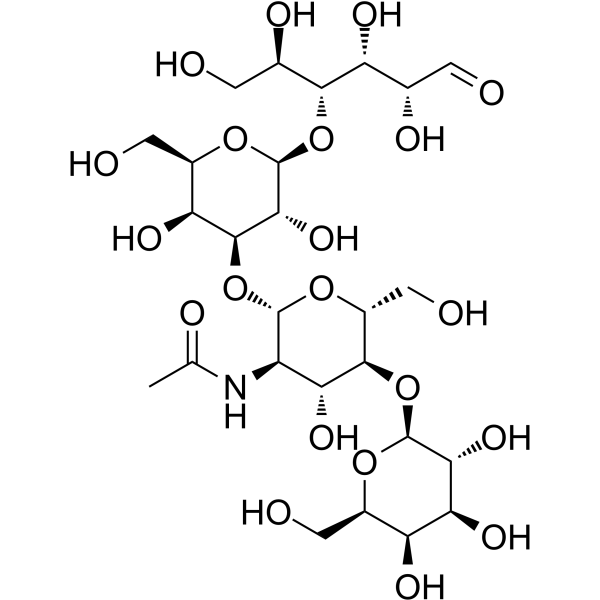Lacto-N-neotetraose

Lacto-N-neotetraose structure
|
Common Name | Lacto-N-neotetraose | ||
|---|---|---|---|---|
| CAS Number | 13007-32-4 | Molecular Weight | 707.63000 | |
| Density | 1.72g/cm3 | Boiling Point | 1173.6ºC at 760mmHg | |
| Molecular Formula | C26H45NO21 | Melting Point | N/A | |
| MSDS | Chinese USA | Flash Point | 663.6ºC | |
Use of Lacto-N-neotetraoseLacto-N-neotetraose (LNnT) is an endogenous metabolite. Lacto-N-neotetraose can inhibit TNF-α induced IL-8 secretion in immature epithelial cells. Lacto-N-neotetraose has anti-inflammatory avtivity, and can improve the wound closure[1][2][4]. |
| Name | β-D-Gal-(1→4)-β-D-GlcNAc-(1→3)-β-D-Gal-(1→4)-D-Glc |
|---|---|
| Synonym | More Synonyms |
| Description | Lacto-N-neotetraose (LNnT) is an endogenous metabolite. Lacto-N-neotetraose can inhibit TNF-α induced IL-8 secretion in immature epithelial cells. Lacto-N-neotetraose has anti-inflammatory avtivity, and can improve the wound closure[1][2][4]. |
|---|---|
| Related Catalog | |
| Target |
Endogenous Metabolite[1], TNFR1[2]. |
| In Vitro | Lacto-N-neotetraose (5 mg/mL, 24 h) induces IL-8 secretion in T84 cells[2]. Lacto-N-neotetraose (5 mg/mL, 24 h) reduces TNF-α induced IL-8-secretion with 38% in FHs 74 Int cells[2]. Lacto-N-neotetraose binds TNFR1 (Tumor necrosis factor receptor 1) with a Kd value of 900 ± 660 nM[2]. Lacto-N-neotetraose (5 mg/mL, 24 h) attenuates TNF-α induced inflammation by TNFR1 ectodomain shedding in FHs 74 Int cells[2]. |
| In Vivo | Lacto-N-neotetraose (100 μM, intratracheal administration for 24 h) reduces the abundance of Streptococcus pneumonia in the lungs of pneumonia rabbits[3]. Lacto-N-neotetraose (100/200 μg, Intradermal injection, at 3, 7, 14, and 21 days post-surgery) increases the wound closure rate on day 7 post-wounding[4]. Animal Model: Rabbit model of pneumonia[3] Dosage: 100 μM Administration: Intratracheal administration for 24 h Result: Decreased by ~2 logs the bacterial load in the lung at 48 h after challenge. Eliminated the extensive, edematous right middle lobe lesion evident at 48 h in control animals. Animal Model: Mice with symmetric full-thickness wounds Dosage: 100, 200 μg Administration: Intradermal injection, at 3, 7, 14, and 21 days post-surgery. Result: Exhibited better healing score, follicle formation, and lower epidermal thickness index (H&E staining). |
| References |
| Density | 1.72g/cm3 |
|---|---|
| Boiling Point | 1173.6ºC at 760mmHg |
| Molecular Formula | C26H45NO21 |
| Molecular Weight | 707.63000 |
| Flash Point | 663.6ºC |
| Exact Mass | 707.24800 |
| PSA | 356.70000 |
| Vapour Pressure | 0mmHg at 25°C |
| Index of Refraction | 1.668 |
| Storage condition | 2-8°C |
| RIDADR | NONH for all modes of transport |
|---|---|
| WGK Germany | 3 |
|
Chemo-enzymatic supported synthesis of the 3-sulfated Lewis a pentasaccharide on a multimeric polyethylene glycol.
Carbohydr. Res. 343(5) , 970-6, (2008) The 3-sulfated Lewis(a) pentasaccharide was synthesized on multimeric-based polyethylene glycol support. Coupling of O-(2,3,4,6-tetra-O-acetyl-beta-D-galactopyranosyl)-(1-->3)-4,6-di-O-acetyl-2-deoxy-... |
|
|
Enhanced factor H binding to sialylated Gonococci is restricted to the sialylated lacto-N-neotetraose lipooligosaccharide species: implications for serum resistance and evidence for a bifunctional lipooligosaccharide sialyltransferase in Gonococci.
Infect. Immun. 73(11) , 7390-7, (2005) We isolated serologically identical (by serovar determination and porin variable region [VR] typing) strains of Neisseria gonorrhoeae from an infected male and two of his monogamous female sex partner... |
|
|
Syntheses of a series of lacto-N-neotetraose clusters using a carbosilane dendrimer scaffold.
Carbohydr. Res. 341(4) , 467-73, (2006) 4-Pentenyl (2,3,4,6-tetra-O-acetyl-beta-d-galactopyranosyl)-(1-->4)-(3,6-di-O-acetyl-2-deoxy-2-phthalimido-beta-d-glucopyranosyl)-(1-->3)-(2,6-di-O-benzoyl-beta-d-galactopyranosyl)-(1-->4)-2,3,6-tri-O... |
| LACTO-N-NEOTETRAOSE |
| Lacto-N-neo-tetraose |
| beta-D-Gal-(1->4)-beta-D-GlcNAc-(1->3)-beta-D-Gal-(1->4)-D-Glc |